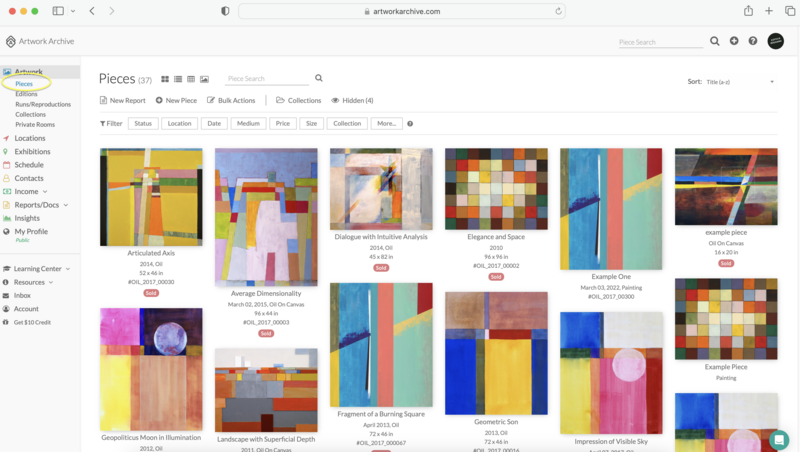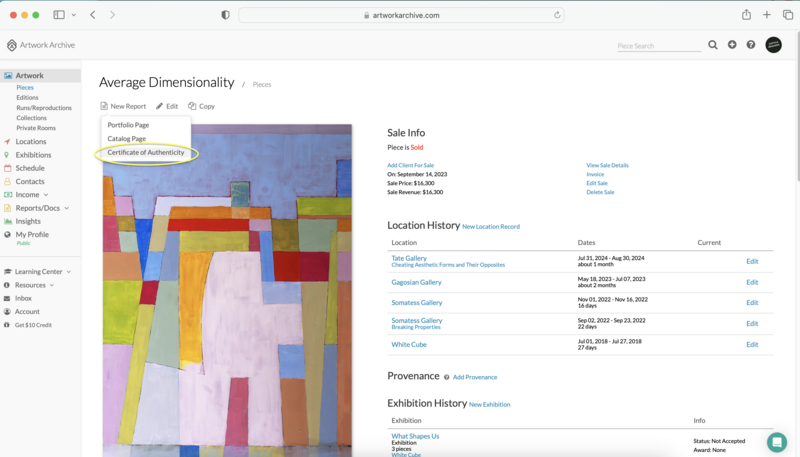
Do You Need a Certificate of Authenticity for Your Art?
To COA or Not to COA, that's the question. Lately, we’ve heard a lot of artists asking about whether or not to include a Certificate of Authenticity with their art.
Even if you are just starting out or feel doubtful your art will ever become that collectible—the answer to this question is a resounding yes!
The trajectory of an artist's career is unpredictable, and a signed, comprehensive COA plays a critical role in supporting collectors when it comes to tracing your piece’s history and proving it’s the original. Plus, let’s not forget that a COA adds to your provenance and can seriously boost your art’s value.
If you're not already including a COA with each sale of your artwork, it may be time to start. Here are some reasons why.
A COA confirms your artwork is genuine
In the art world, where the line between original masterpieces and convincing fakes can be thin, having a COA is essential. It serves as concrete proof that the artwork you've poured your heart and soul into, is authentic, setting it apart from unauthorized reproductions or forgeries.
When you present a COA with your artwork, you're also presenting a stamp of its legitimacy. It's a clear signal to everyone—collectors, galleries, and the general public—that your art is authentic and has been created by you.
A COA can increase your artwork's value
Certifying the authenticity of your artwork can significantly enhance its market and resale value. In the art market, the provenance and authenticity of a piece can greatly influence its desirability. So, a COA positions your work as a more attractive and secure investment.
Authenticity matters deeply to those who invest in art, as it ensures the artwork's legitimacy and its potential to appreciate in value over time.
A COA helps build provenance
Your art deserves to have its own backstory, showing its journey through time and the different owners it may have had—a COA gives it one.
Building this provenance for your artwork adds a layer of historical context, value, and intrigue, making it even more special.
Want to learn more about provenance and why it should matter to you? Click here.
A COA increases your collectors' confidence in you as an artist.
Trust is a key part of establishing a strong, positive reputation within the art community and among your potential buyers. When you include a COA with your artwork, you're essentially telling your collectors that you stand firmly behind your work.
It's a declaration of your confidence in your artistic abilities and the originality of your ideas. This level of confidence can be contagious. Collectors who see that you're serious about the quality and authenticity of your work are more likely to feel secure in their decision to invest in you.
A COA can help with insurance claims
If something ever happens to your artwork, like it gets lost, damaged, or stolen, having a Certificate of Authenticity can be a game-changer for dealing with insurance.
It shows your insurance company exactly what your artwork is worth. This means you can breathe a little easier knowing you'll likely get the right coverage or compensation for it.
A COA adds a layer of legal protection
We've all heard those horror stories where artists get tangled up in copyright messes. If anyone ever questions whether your artwork is really yours or if it's the original, having a Certificate of Authenticity can make a big difference.
A COA offers the legal backing to support your artwork's originality. This can be particularly valuable in protecting your rights as an artist.
A COA helps contribute to your artistic legacy
When you create art, you're creating something that could exist long after you're gone—you're building a legacy that can live on for generations. Issuing a Certificate of Authenticity with each of your pieces is a smart move to make sure this legacy is preserved the way you want it to be.
A COA protects your work's value, provenance, story, and authenticity, making sure its significance isn't lost over time. Whether your pieces end up in galleries, museums, private collections, or even passed down through your family, this certificate helps preserve and maintain your artistic legacy.
A COA demonstrates your professionalism as an artist
Offering a COA shows you mean business and you take your artwork (and yourself as an artist) seriously. It's a clear indication that you're not just passionate about creating your work, but also deeply committed to the integrity and longevity of it.
By making sure a COA accompanies each piece, you're protecting the buyer and the legacy of the artwork and also setting a precedent for transparency and trustworthiness in your professional relationships.
Look at it as a strategic move that poises you as a serious and responsible artist.
Artwork Archive Tip:
Another way to demonstrate your professionalism? Staying organized with an inventory management system like Artwork Archive. You can manage and track your artwork and be sure that all of the important details about each piece are easily accessible. Plus, you can generate, send, and store all of your Certificates of Authenticity, keeping your records complete and up-to-date.
So, how do you go about creating a Certificate of Authenticity? Take a sigh of relief, because, in four easy steps, you can make a professional COA right from Artwork Archive.
To make your own Certificate of Authenticity on Artwork Archive, follow this short tutorial:
1. First, select the piece for which you need to create a Certificate of Authenticity.
Artwork Archive Tip:
If you haven’t already, this is a great time to mark the piece as sold. That way you can keep track of who bought what, when, and for how much, plus get insights to inform your art business strategy.

2. Click on 'New Report', and from the drop-down menu, select 'Certificate of Authenticity' to start creating your document.

3. Next, fill in the details you want to include, such as price, an image or logo, and text where you should express copyright protection, and more.
Here is sample wording you can use or adapt for your own artwork:
“This artwork is a one-of-a-kind original piece, derived from my own observation, imagination, sketch or photograph. All copyrights and reproduction rights are retained by [Artist’s Name]. This artwork may not be reproduced by any process or medium without the express written permission of the artist.”
Important details like medium, dimensions, and title will automatically be included in your piece from your Artwork Archive account.

Artwork Archive Tip:
Want to save your own words to use on all of your COA's? Just click: "Save as Template" when generating your Certificate and all of your settings, including your custom wording, will be saved and applied to any other COA you generate.
4. Once you’ve finalized the details, just click 'Generate.' You’ll be redirected to Reports where you can download, print, sign, and date a certificate that’s ready to be shipped out with your art!
Certificate of Authenticity Examples on Artwork Archive

An example of a Certificate of Authenticity in Artwork Archive. Learn more about how to create your own COA here, or sign up for the free trial to make your own.
Ready to make your Certificate of Authenticity and more reports with the click of a button? Start your free 14-day trial of Artwork Archive.






